Planning to visit the 21 California missions? The Spanish missions of California are laid out along the old El Camino Real, and make for a fascinating historical road trip along the coast.
The missions in California stretch from San Diego up to Sonoma, and the associated settlements are considered the start point of the development of major cities in California, from San Francisco to San Jose, Santa Barbara, and San Diego.
The California missions were established by Spanish missionaries between 1769 and 1823.
If you love history, culture, art and architecture, the missions offer an in-depth look back into the era of the Spanish friars in California’s past.
We’ve described the missions in order from south to north in this article, in the event you are planning a road trip to cover them all.
Most of the missions are located close to lodging and dining, and fit well into a broader California coast road trip itinerary. Of course, you can also visit them individually over time, as you visit different parts of California.
Be sure to check the websites of the mission(s) you plan to cover, as visiting hours tend to change from time to time. You’ll need several days to cover the 21 missions on a road trip: we did it in seven days, but ideally you’d allow 10 days and do other things along the way!
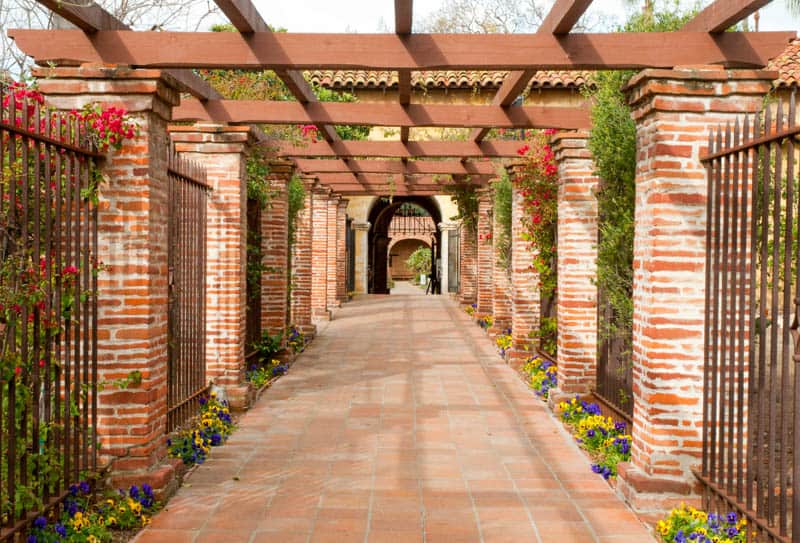
Some links on this page may be affiliate links. If you click an affiliate link and make a purchase, we may receive a small commission, at no extra cost to you. For more details, refer to our disclosure.
A Brief History of the Spanish Missions of California
Located about 30 miles apart from one another, such that a rider on horseback could travel from one to the next in a day, the missions of California were set up so that the Franciscan friars dispatched by the Spanish crown could evangelize native peoples and help the Spanish empire expand in Alta California.
The missions sustained themselves through agriculture and livestock raising, and the more successful missions eventually controlled a large amount of land.
Converted Native Americans, known as neophytes, cultivated the land and performed other tasks under the guidance of the Spanish friars to keep the missions running and growing.
In 1833, Mexico, which had taken control of Alta California following the Mexican War of Independence, passed the Secularization Act, under which mission lands were parceled off and gifted to loyal soldiers, leading to the Rancho era in California history.
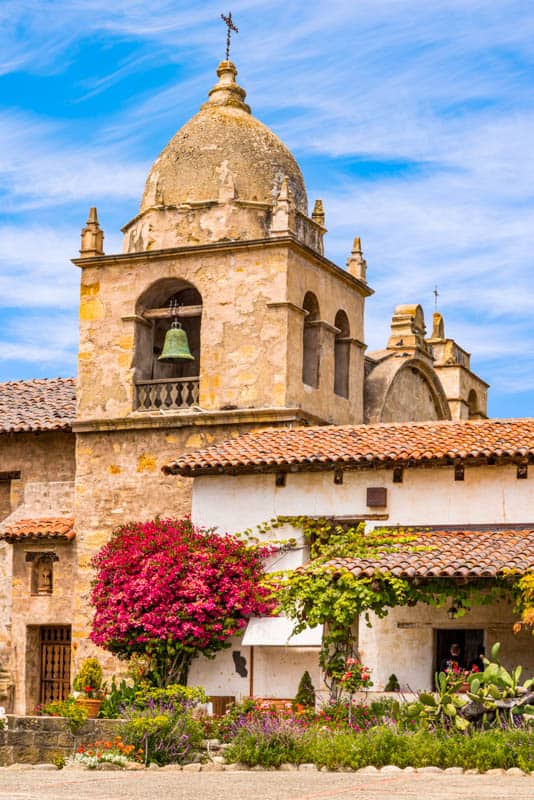
After California came under US control, the missions were returned to the Catholic Church, many of them in ruins, and the task of restoration began. Today many of the mission churches function as active parish churches.
California’s missions, as some of the state’s oldest structures, are popular destinations for visitors that want to learn about California’s mission era and experience some of the art, architecture, and gardens of the time.
You can visit the churches, tour the museums, and stroll the grounds and gardens.
The California Missions from South to North
Mission San Diego de Alcalá
Founded in 1769, the San Diego Mission was the first Franciscan mission established in California by Spain.
Friar Junípero Serra (now a saint), founded the mission in the land of the Kumeyaay people. It is known as the “Mother of the Missions.”
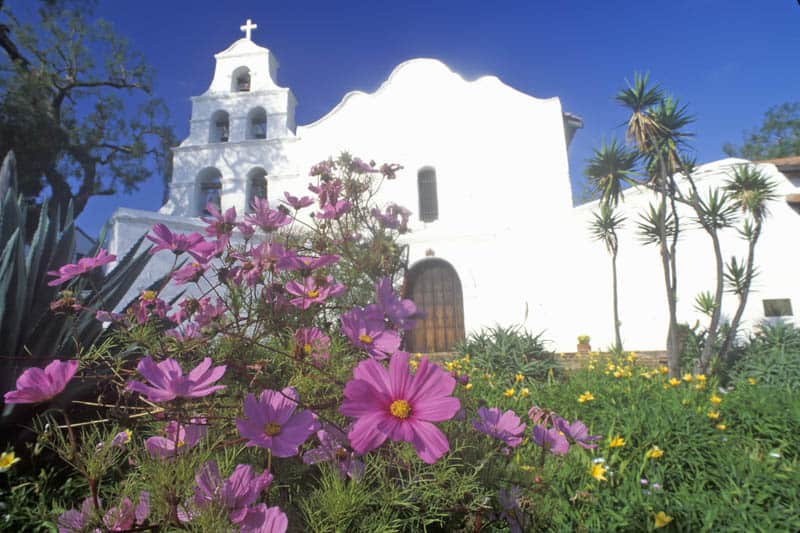
The gardens of the mission are beautiful, with roses, succulents, other plants and trees, and artifacts, and make for a delightful stroll. Some of the plants here are quite old!
You will also find statues of Junipero Serra and Saint Joseph in the garden, along with memorials to Native Americans that perished at the mission. Padre Luis Jayme, the first European martyr in Alta California, is buried here.
Inside the basilica, you can view paintings, sculptures, and other artifacts. Guided tours are offered on weekdays, and the gift shop offers free brochures as well.
The campanario (bell tower) is one of the most striking features of the San Diego Mission. It holds the five mission bells, the heaviest of which weighs 1,200 pounds!
Location: 10818 San Diego Mission Rd, San Diego, CA 92108
Mission San Luis Rey de Francía
Named for King Louis IX of France, Mission San Luis Rey was founded in 1798, the eighteenth Spanish mission in Alta California. It was established by Father Fermín Lasuén, Father Serra’s successor.
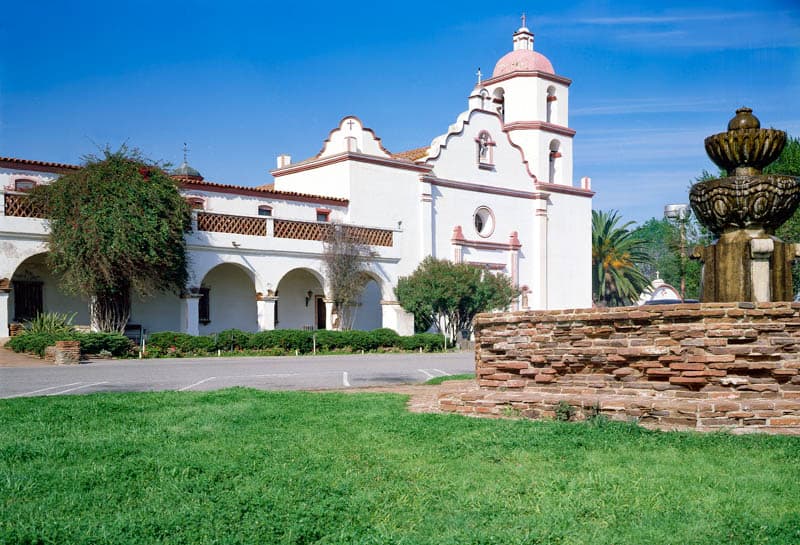
Mission San Luis Rey is known as the “King of the Missions.” The current church is the third built at the site, and today it functions as an active parish church. The 1815 building, with its pristine white facade, is a National Historic Landmark.
Don’t miss the first California pepper tree, planted at the mission in 1830. It features pink peppercorns. Stroll the gardens and visit the small cemetery.
The church is open year-round for meditation and private prayer, and the mission functions as a retreat center as well.
The museum is a fascinating look into life as it existed in the time of the friars. You can take a self-guided tour through the different rooms, courtyard, gardens, and the church.
Location: 4050 Mission Ave, Oceanside, CA 92057
Mission San Juan Capistrano
Mission San Juan Capistrano was founded in November 1776 by Junipero Serra, the seventh of California’s twenty-one missions. It is known as the “Jewel of the Missions.”
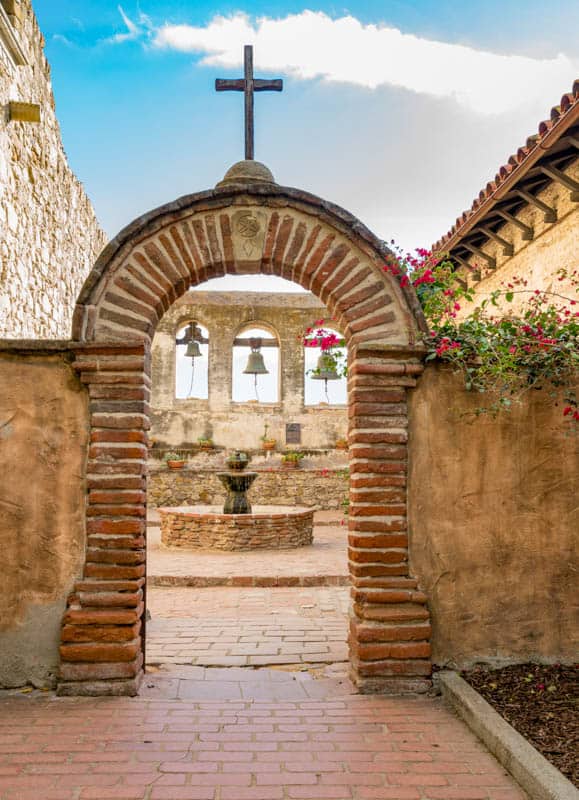
Over succeeding years, many Acjachemen people joined the mission, but after 1812, Mission San Juan Capistrano fell into a decline.
The earthquake of 1812 destroyed the Great Stone Church. A new church, Mission Basilica San Juan Capistrano, was built in 1984, and the mission compound is today a museum.
You can take an audio self-guided tour through the exhibit rooms and grounds of the beautiful mission. The older bells of the mission are on display, but they were replaced on the bell wall by new bells in 2000.
You can see many artifacts from the time of the mission padres, paintings, and an exhibit dedicated to Native American art. The 1914 statue, Coming of the Two Sculptures, portrays Father Serra with a Native American boy.
Mission San Juan Capistrano is known for the return of the swallows. A large flock of American cliff swallows has been coming to nest at the mission in March each year, leaving in October for the south. Sadly, their numbers have dwindled in recent years.
Location: 26801 Ortega Hwy, San Juan Capistrano, CA 92675
Mission San Gabriel Arcángel
Founded in 1771 by Father Junipero Serra, Mission San Gabriel was the fourth of California’s Spanish missions. This mission is unique for its Moorish-style architecture, with capped buttresses and narrow slit windows.
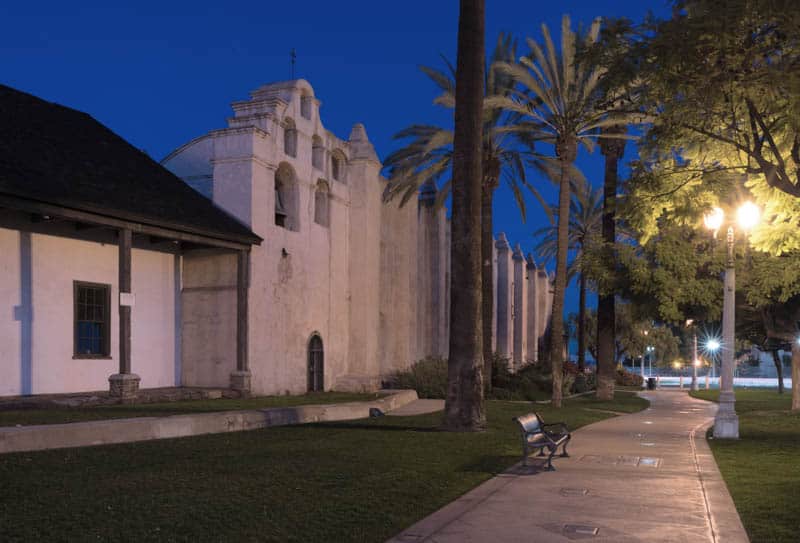
From an agricultural perspective, Mission San Gabriel was the most productive of the Spanish missions, producing a variety of food crops and raising cattle and sheep. It is nicknamed “Queen of the Missions.”
The bell wall at the San Gabriel Mission features six bells, the heaviest of which weighs over one ton. The oldest bell dates back to the late 18th century, and was cast in Mexico City.
Today you can tour the church, museum, grounds, and gardens of the mission. There is also a gift shop you can browse. A statue of Saint Serra graces the front of the church, one of many life-sized statues of the saint erected by William Hannon.
You must not miss the Stations of the Cross at Mission San Gabriel, said to have been painted by neophytes at the mission. You will also find artifacts and historical markers on the grounds.
Note: At the time of writing, the church is still being restored after a fire damaged it in July 2020. It is expected to re-open in December 2022.
Location: 428 S. Mission Drive, San Gabriel, CA 91776
Mission San Fernando Rey de España
The San Fernando Rey de Espana Mission was founded in 1797 by Padre Fermin Francisco de Lasuén, successor to Saint Serra. It is the seventeenth of California’s twenty-one missions, and known as “Mission of the Valley.”
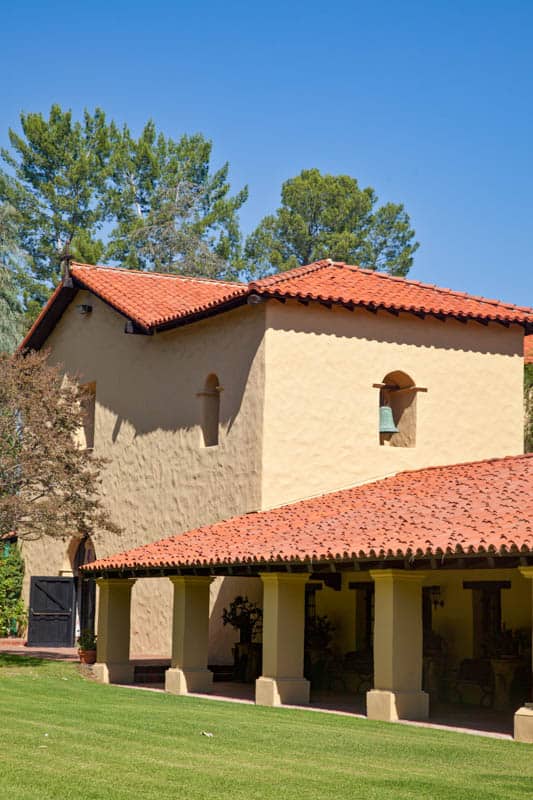
The exterior of Mission San Fernando is beautiful, with a large fountain in the center of the courtyard. The garden houses numerous varieties of plants, including mature trees and succulents. You may also see (and hear!) the peacocks that live here.
The building that contained the mission workshops is now a museum, and here you will see various artifacts, including statues of Catholic saints, plus pots, baskets, and lots of interesting old photos.
The two-story Convento, completed in 1822, is the most significant part of Mission San Fernando. It is the oldest surviving structure at the mission, and the largest adobe structure in all the missions. It has been painstakingly restored, and houses many paintings and artifacts.
You can walk through the cemetery, where thousands of Native Americans are buried. The Bob Hope Memorial Garden contains a garden and meditation area, and a crypt where Bob and Dolores Hope are buried.
Location: 15151 San Fernando Mission Blvd, Mission Hills, CA 91345
Mission San Buenaventura
Established in 1782 by Saint Junipero Serra, Mission San Buenaventura is the ninth of the California missions. It was the last mission founded by Saint Serra. It is nicknamed “Mission by the Sea.”
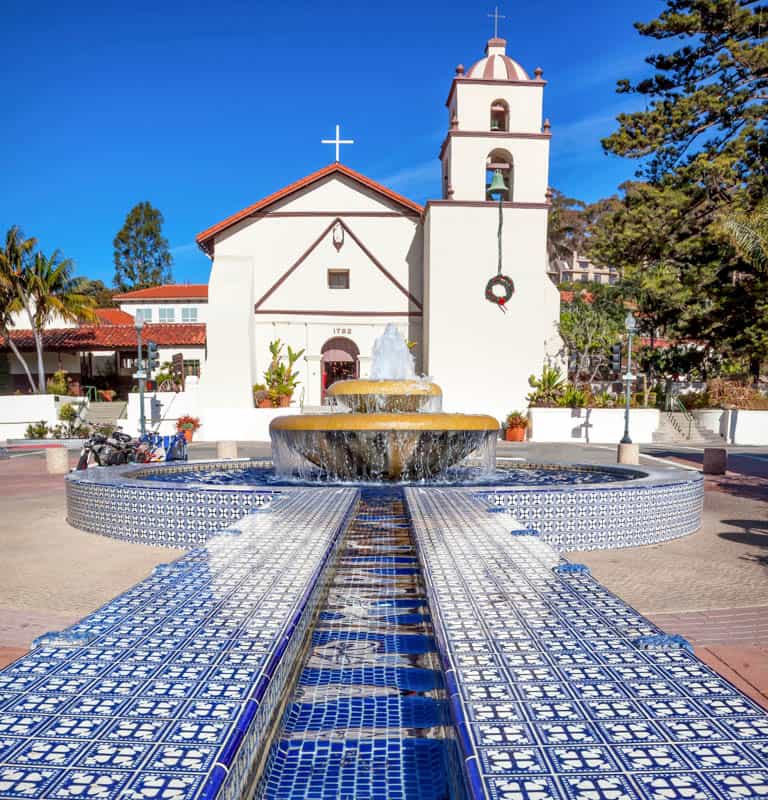
Because of the construction of a canal from the Ventura River to the mission, Mission San Buenaventura grew a wide variety of crops, including grains, vegetables, and fruit from grapes and apples to bananas, coconuts, and figs.
Today you can tour the mission church, museum, garden, and grounds. The garden, which is situated between the church and the museum, has a Hannon statue of Saint Serra. Visitors rub the big toe for luck. The garden has a restored olive press and a water settling tank.
The restored church has a beautiful bell tower that houses five bells. Inside, the main altar is from Mexico and dates back to the early 19th century. It includes a statue of Saint Bonaventure, for whom the mission is named.
The interior also contains oil paintings that depict the fourteen Stations of the Cross.
A small museum is located by the gift shop, and contains many artifacts, including a couple of bells made from wood, vestments, chalices, and baskets. Here you will find a model of the mission as well.
Location: 211 E. Main Street, Ventura, CA 93001
Mission Santa Barbara
Located on a hill overlooking much of the city of Santa Barbara, Mission Santa Barbara is nicknamed “Queen of the Missions” because of its stunning exterior.
Established in 1786 by Padre Fermin Francisco de Lasuén, it is the tenth mission founded by the Franciscans in Alta California.
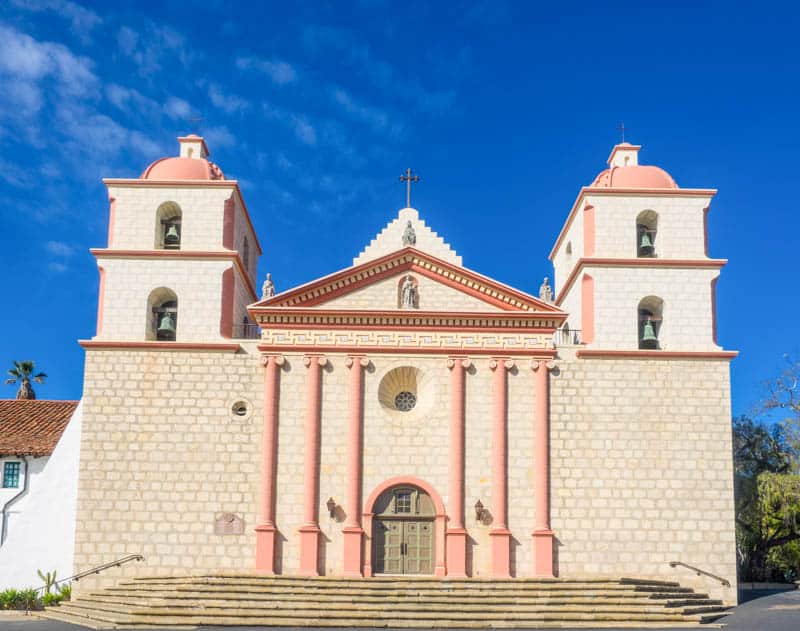
The church as we see it today was completed in 1820. Santa Barbara has two bell towers, unlike most of the other missions. The beautiful Moorish fountain in the front is from the early 19th century. At the top of the facade are four statues: Faith, Hope, Charity, and Santa Barbara.
The multi-room museum houses numerous exhibits, including reproductions of a mission bedroom and a mission kitchen, and three of the four original statues from the facade, made by the Chumash. The statues were replaced after they were damaged by an earthquake in 1925.
Inside the church, don’t miss the original mission altar, now in the Baptistery at the back of the church. It is the only surviving original mission altar.
The Sacred Garden is the perfect place for a meditative stroll. It has rose beds, stately palms, hedges, and other plantings, and looks beautiful.
The cemetery is another serene space. It houses the burial sites of both Chumash and Spanish settlers.
Location: 2201 Laguna St, Santa Barbara, CA 93105
Mission Santa Ines
Mission Santa Ines was founded in 1804 by Padre Estévan Tápis. It is the nineteenth of the twenty-one California missions.
The location of this mission is fabulous, with views over the Santa Ynez Valley and the distant mountains from the grounds.
Visiting the picturesque mission is one of the best things to do in Solvang if you enjoy delving into local history.
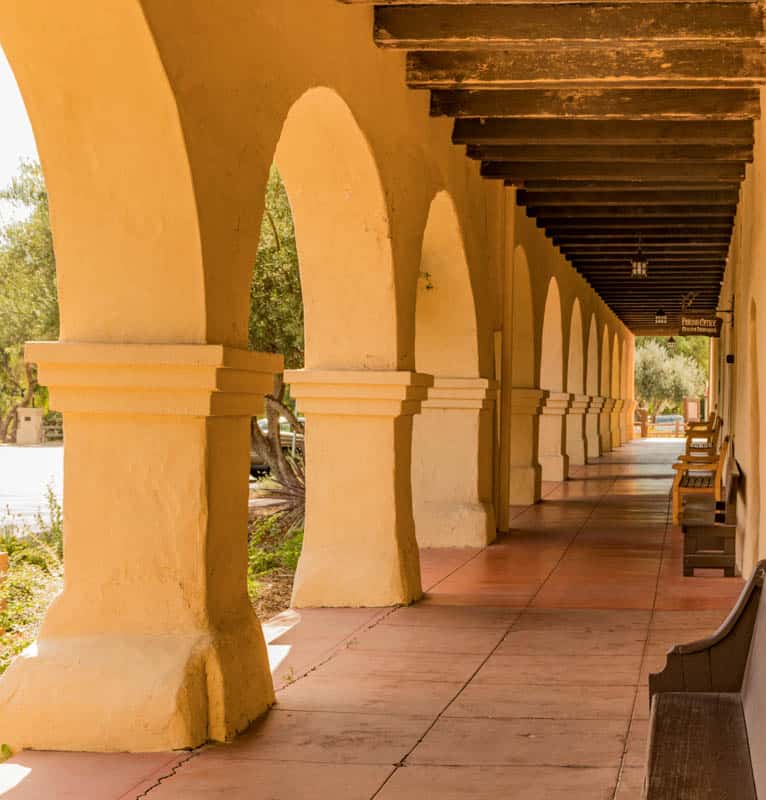
The exterior of the mission is lovely, with a campanario that houses the bells of the mission on one side of the church and a long arched corridor on the other side with doors leading into rooms.
You can enter the mission museum through the gift shop. There are ornate vestments in several colors on display, along with a model of the mission, the original bells, pottery, and other artifacts. A Madonna Chapel adorns one room.
The church is an active parish church. It is long and narrow, with a beautiful altar and wood beams across the ceiling. Various statues and paintings decorate the interior.
In the former mission quadrangle, you will find today’s mission garden, which is home to a variety of mature succulents and other plantings, and a large fountain.
A Fulling Mill and a Grist Mill were part of the complex of buildings belonging to the Mission Santa Ines, and you may be able to see the location from the parking lot. You can walk the Olive Grove Trail to the mills if you want to view them up close.
Location: 1760 Mission Drive, Solvang, CA 93463
Mission La Purísima Concepción
Mission La Purísima Concepción was founded in 1787 by Padre Fermin Francisco de Lasuén. It is the eleventh mission founded in California by the Spanish. The current mission represents the restoration after the 1812 earthquake.
La Purísima is a State Historic Park.
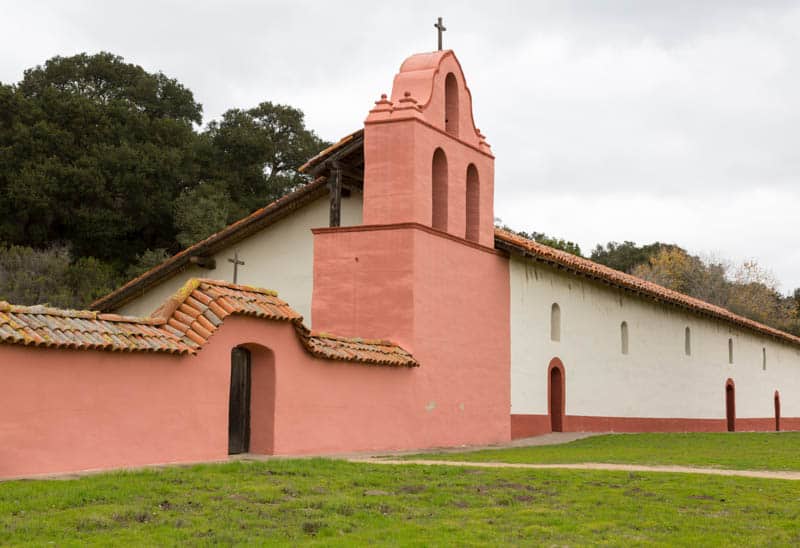
Ten of the original mission buildings have been restored and furnished, including the church, shops, living quarters, and blacksmith shop. Thus, Mission La Purísima Concepción is the most extensively restored California mission.
Start your tour at the visitor center, where you will find information, artifacts, and exhibits. Then take a self-guided tour of the complex. At the livestock corral, you will find animals similar to those that were there when the mission was functioning: cattle, goats, and horses.
From the cemetery, you get a great view of the campanario, with its three bells. Near the cemetery are the pits where tallow was drawn from beef fat for use in candles or soap.
The church interior has been recreated to look as it was during the mission era. It is not an active church, and it does not have pews, since folks stood during services in the mission era. You can also tour the garden and the reconstructed Native American village.
Guided tours and special events through the year bring history to life at the Mission La Purísima Concepción, with docents dressing up in costumes or candlelight tours.
Location: 2295 Purisima Road, Lompoc, CA 93436
Mission San Luis Obispo de Tolosa
Founded in 1772 by Saint Junipero Serra, Mission San Luis Obispo de Tolosa was the fifth of California’s twenty-one missions. Known as the “Prince of the Missions,” San Luis Obispo’s mission had a roof made from some of the earliest roof tiles made in California.
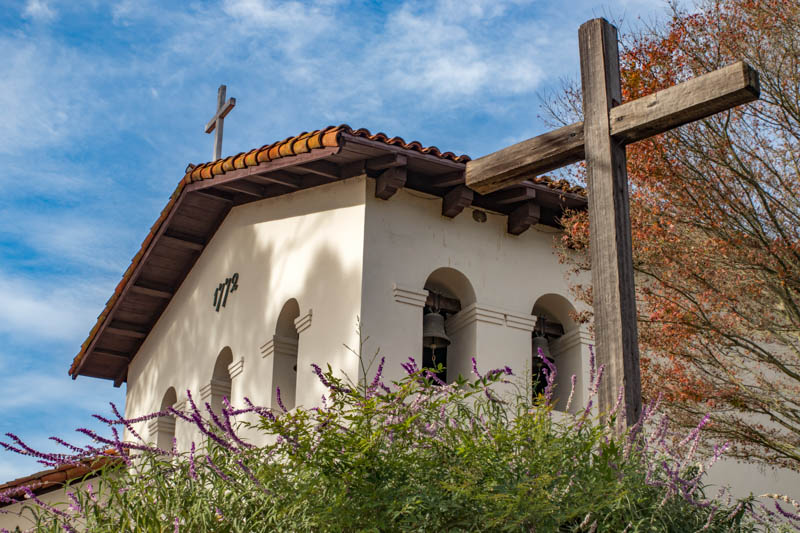
The SLO Mission is a beautiful structure, conveniently located in downtown San Luis Obispo. The long corridor that led into the living quarters of the missionaries has a colonnade of round columns. In the plaza, you will find the Hannon statue of Saint Serra, and the cross of the mission.
As you go up the steps into the gift shop and museum, you’ll pass under the five bells of the mission, which were placed in 2005. The old bells are on display in the courtyard. The five new bells are named for the first five missions.
The small museum houses exhibits and photos, including about the Chumash, the native people of the area, vestments, and information about materials used in the construction of the mission.
The church contains some art from the 1800s, but otherwise has been restored. It is an active parish church. The garden is small but contains numerous plantings, including a grape arbor.
Location: 751 Palm Street, San Luis Obispo, CA 93401
Mission San Miguel Arcángel
Located near the Central California wine country town of Paso Robles, Mission San Miguel is named for the Archangel, and was founded in 1797 by Padre Fermin Francisco de Lasuén. It is the sixteenth Spanish mission in California.
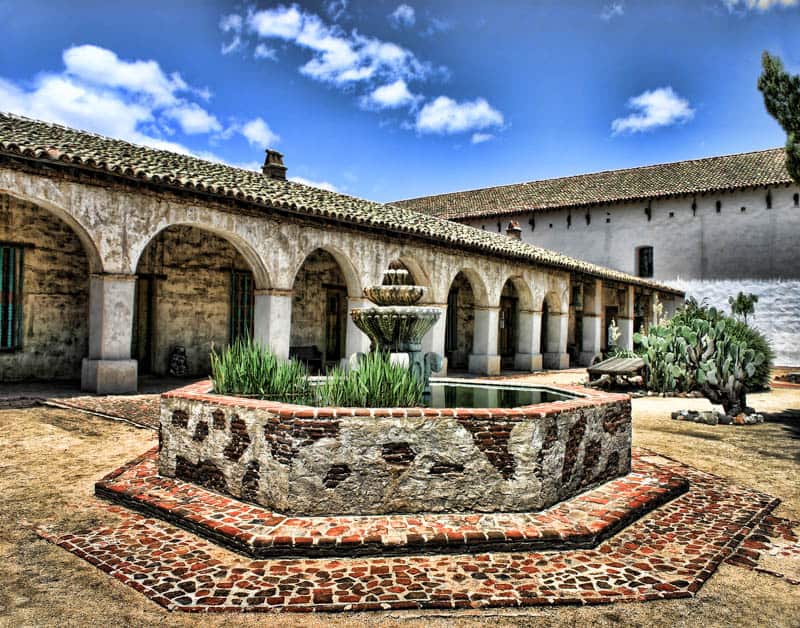
The church built in 1797 perished in a fire a few years later, after which an adobe and tile structure was built. The church is famous for the frescoes by Esteban Munras in the interior.
The museum contains a beautiful wood sculpture of San Miguel from Spain, which dates back to the 16th century. You will vestments and other exhibits, and models of Mission San Miguel and Mission San Antonio de Padua, created by San Quentin inmates.
The garden and grounds contain many interesting artifacts, so allow for time to stroll. You can also tour the living quarters of the padres, and the cemetery.
The church interior is beautiful, with the original decorations and frescoes, reportedly done with local coloring materials. The colors are still bright. At the top of the altar is a depiction of the “Eye of Heaven.”
Location: 775 Mission Street, San Miguel, CA 93451
Mission San Antonio de Padua
Mission San Antonio de Padua was founded by Saint Junipero Serra in 1771, the third of California’s twenty-one missions. Located in the Fort Hunter Liggett Military Reservation, the San Antonio Mission is quite a bit off any main highways.
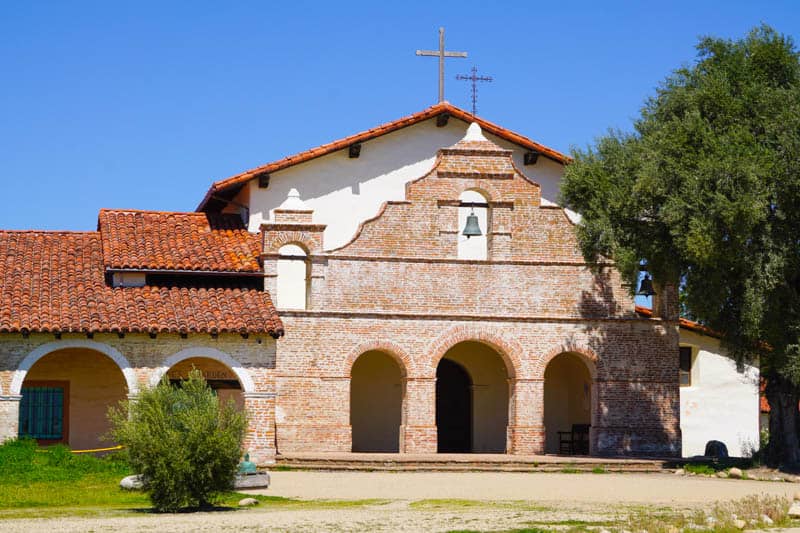
Because it’s in the middle of countryside, the views from the front of the mission are pretty. We visited in the spring, when there were lots of wildflowers in the surrounding meadows. It is rattlesnake country though, so be careful if you decide to wander the area.
The campanario, which holds three bells, is a structure in front of the church facade. The design is quite unique. There is a Hannon statue of Saint Serra in the front.
The mission museum houses numerous exhibits relating to mission life and various occupations from the time, from weaving to wine making. The garden is laid out in the courtyard, with a fountain and various plantings.
The church is an active parish church. Although it has been restored, the design appears to follow what it probably would have looked like in mission times. The altar holds some statues original to the mission.
Location: 1 Mission Creek Road, Jolon, CA 93928
Mission Nuestra Señora de la Soledad
Mission Nuestra Señora de la Soledad was founded in 1791 by Padre Fermin Francisco de Lasuén, the thirteenth of California’s 21 missions. The original structures were destroyed by floods for the most part, and the present church is a reconstruction.
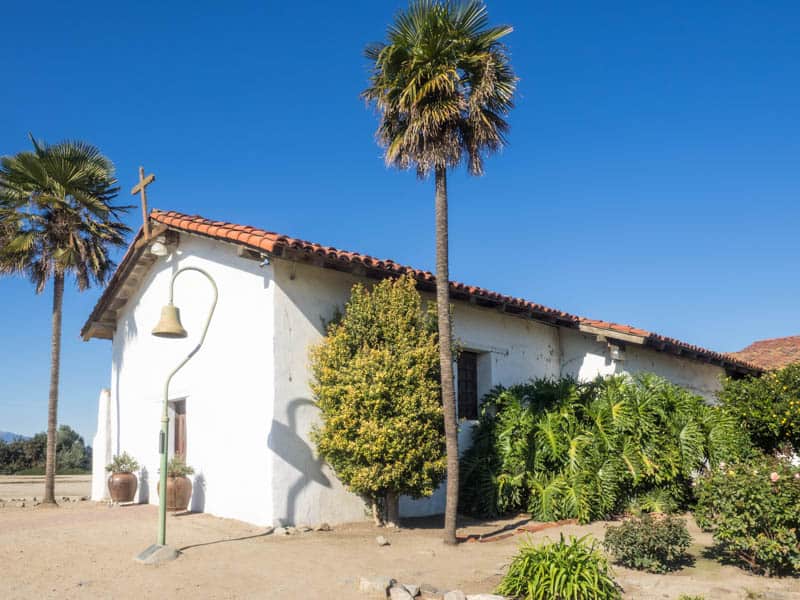
The reconstructed chapel at the Soledad Mission is small, and not at the location of the original church. The stenciled wall decorations are charming. A statue of Our Lady of Sorrows is at the top of the altar. The 14 Stations of the Cross are depicted in paintings.
The complex includes a gift shop and museum. The museum includes an exhibit that describes the life of the native peoples of the area before the arrival of the Spanish, another one that depicts the Mission era, and one from the Rancho era. The original mission bell is displayed in the museum.
You can also explore the ruins of the original structures. A marker indicates the site of the original church and various other markers indicate burial sites. Bits and pieces of the original adobe walls are still visible.
Location: 36641 Fort Romie Road, Soledad, CA 93960
Mission San Carlos Borromeo de Carmelo
Founded in 1770 by Saint Junipero Serra, Mission San Carlos was the second of the Spanish missions in California. Saint Serra is buried near the sanctuary here, as is Padre Fermin Francisco de Lasuen.
The mission is one of the must-visit sights in Carmel.
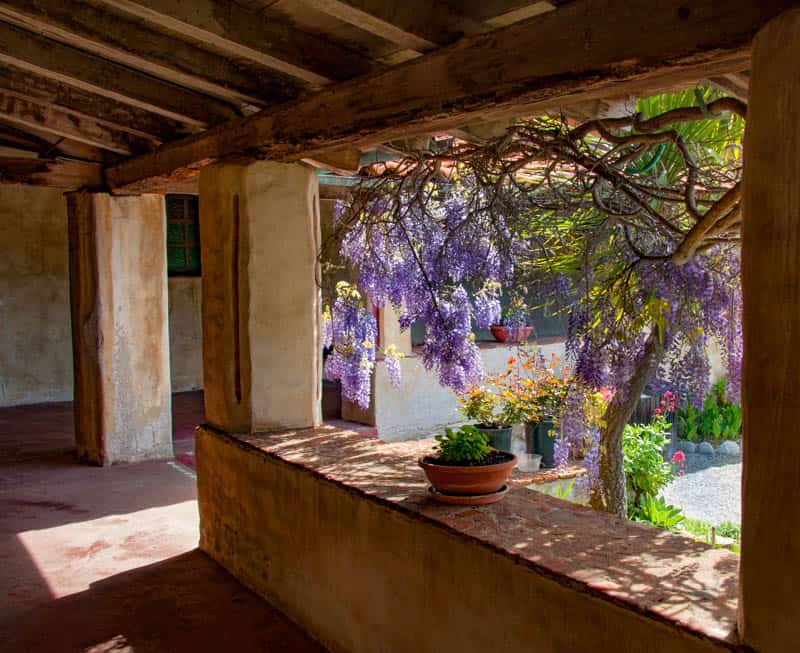
The Mission Basilica was completed in 1797, and is one of the most beautiful structures you will see across all the California missions.
The Moorish design features two asymmetrical towers, one topped by a dome. The warm ochre front facade includes an ornamented entrance.
The garden of the Carmel Mission is gorgeous, with lots of flowers in season, and mature trees. A large stone fountain is the focal point of the garden. In the courtyard at the back is the original mission fountain.
The interior of the basilica has been restored after the ceiling collapsed in the 19th century, but many of the statues, paintings, and artifacts are original: they were removed from the church before it was damaged and brought back later. The Serra Memorial Cenotaph is by Jo Mora.
Orchard House, located off the front courtyard, is the oldest residential building in California. The adobe was built in 1774. A couple of the pear trees planted at the orchard by Father Francisco Palóu still survive.
Location: 3080 Rio Road, Carmel-By-The-Sea, CA 93923
Mission San Juan Bautista
Mission San Juan Bautista was founded in 1797 by Padre Fermin Francisco de Lasuen, and it is the fifteenth Spanish mission in California. This mission is worth visiting not only in its own right, but also to see the historic district surrounding the mission.
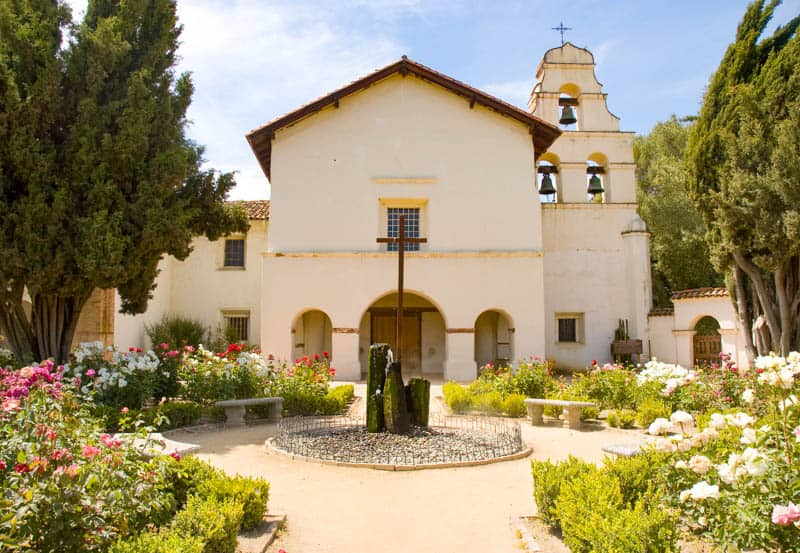
The church at Mission San Juan Bautista is the only three-aisle church you’ll find across the twenty-one missions. The interior of the church has many of the original decorations and statues. On some of the floor tiles, you will see animal prints, created when the tiles were left out to dry in the sun.
The mission museum is housed in the rooms along the corridor which once served as the living quarters for the friars and workshops. It contains a number of artifacts, and reconstructions of the mission kitchen and other areas.
The gardens at Mission San Juan Bautista are large and beautiful, with mature trees, succulents, and various other plants. Artifacts and statues are located at various spots. Near the mission, you can walk a section of the old El Camino Real!
Location: 406 2nd Street, San Juan Bautista, CA 95045
Mission Santa Cruz
Founded in 1791 by Padre Fermin Francisco de Lasuen, Mission Santa Cruz was the twelfth of California’s missions. The mission is named not after a saint, but for the Day of the Exaltation of the Holy Cross.
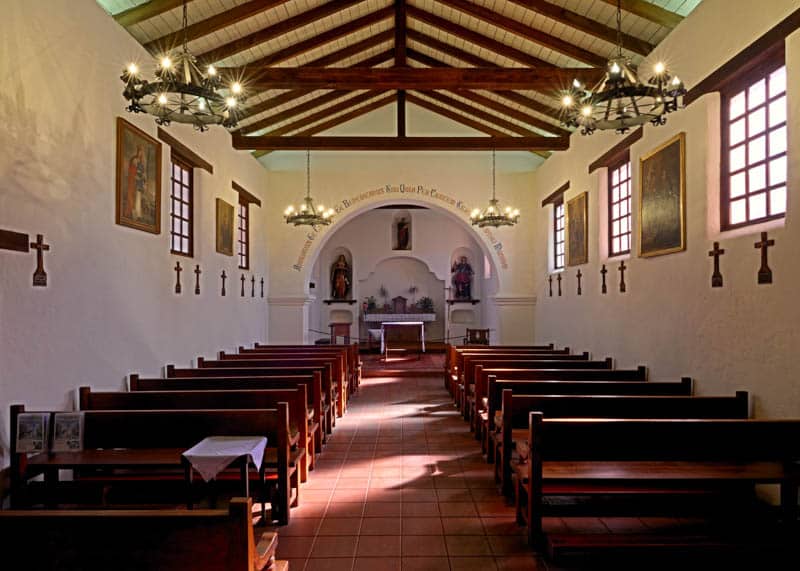
Mission Santa Cruz was plagued by a series of misfortunes over the years. It was affected by floods and earthquakes, and also subject to looting. The current structure, a replica, was built in 1931.
The church contains some original statues and a painting, and a chalice used by Saint Serra. The museum exhibits vestments from different periods.
Nearby is the Santa Cruz Mission State Historic Park, which contains the only building left from the original mission complex, an adobe structure that served as the living quarters for the native people at the mission. Exhibits document the story of the mission from the perspective of the Ohlone and the Yokuts.
Location: 120 Emmett Street, Santa Cruz, CA 95060
Mission Santa Clara de Asis
Mission Santa Clara de Asis was founded in 1777 by Saint Junipero Serra, the eighth of the California missions and the first to be named after a female saint. It was originally sited by the Guadalupe River, but was destroyed in a flood.
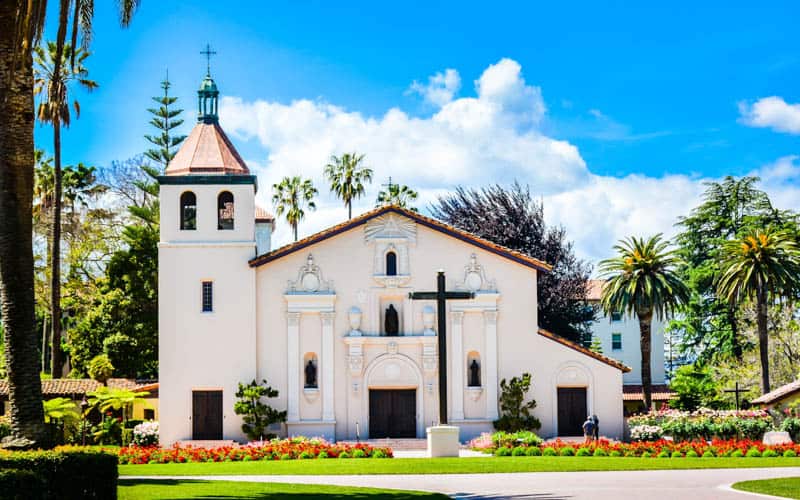
The church was relocated and rebuilt multiple times, following damage from earthquakes and a fire. In 1850, the church and its lands were turned over to the Jesuits, who established the University of Santa Clara in 1851 and set about rebuilding the church, with an Italian-inspired facade and two bell towers.
The current church is from 1926, built after a fire destroyed the prior wooden structure, and serves as the chapel for the University Of Santa Clara. The current design features one tower, and is modeled after an older, 1820s version.
The interior of the church features a beautiful ceiling, arched doorways with stenciled decorations, and a red-tiled floor.
Location: 500 El Camino Real, Santa Clara, CA 95053
Mission San Jose
Founded in 1797 by Padre Fermin Francisco de Lasuen, Mission San Jose is the fourteenth of the California missions. The San Jose Mission was one of the largest of the California missions.
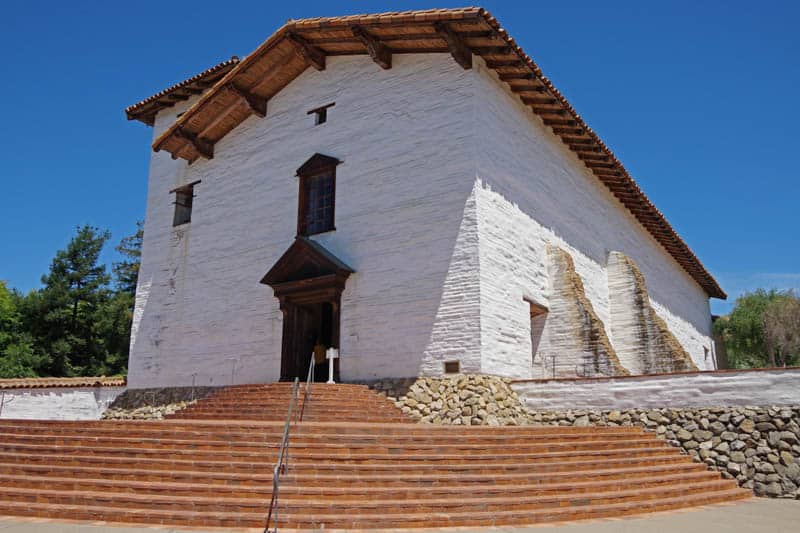
The San Jose mission complex was substantially destroyed by an earthquake in 1868. The Convento, which now houses the museum, was one of the few structures that survived.
The church, built in 1985, is a replica. A wooden church, which stood at the site since the 1868 earthquake, was moved to Burlingame in 1982, before the current church was constructed.
The church is a beautiful re-creation, and looks much like it would looked in the middle of the 19th century. The main altar and the reredos are gorgeous, and include many old statues. The walls have been painted to look like the 1830s creation of Mexican artist Agustín Dávila.
The museum, housed in several rooms, contains exhibits from the era of the native peoples to the 1985 building of the current church. Exhibits run the gamut from paintings to tools and artifacts, vestments, and statues.
The garden has a fountain, a Hannon statue of Saint Serra, and some plantings. The bell tower holds the four bells from the 1868 church.
Location: 43300 Mission Boulevard, Fremont, CA 94539
Mission San Francisco de Asis
Founded in 1776 by Padre Francisco Palóu and Padre Pedro Benito Cambón, Mission San Francisco de Asis is the sixth of the California missions. The structure survived the 1906 San Francisco earthquake and is the oldest intact building in the city.
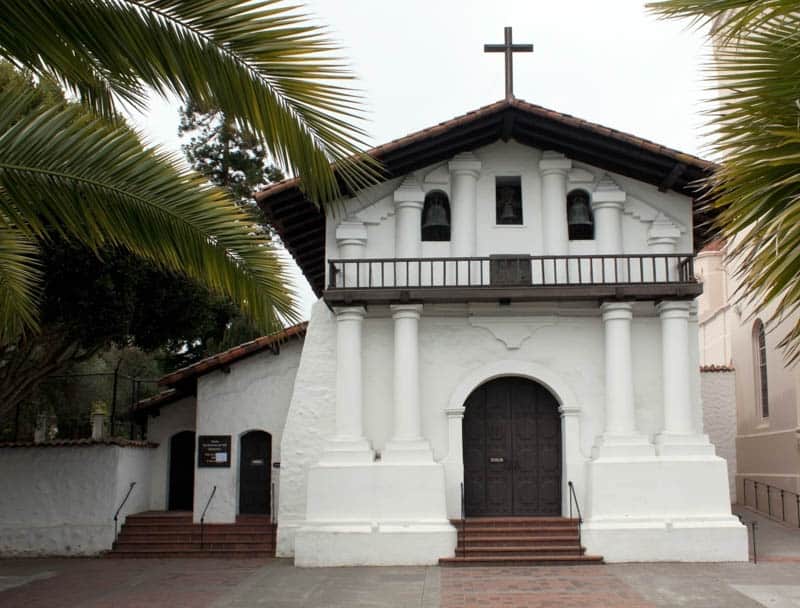
Mission San Francisco de Asis is also known as Mission Dolores, because it was originally sited near a stream called Arroyo de los Dolores. The mission is not an active church, although services are held here on special occasions.
The charming church exterior has a balcony, and is decorated with round columns. There are no bells hung on the exterior of this church. The inside is beautiful, belying the simple facade.
The interior of the church features a stunning painted ceiling and an ornate main altar and reredos. There are many paintings on the walls. The interior of the San Francisco Mission is probably one of the most spectacular across all the California missions.
The museum is small, and includes vestments and artifacts from the time of the native peoples to the mission era and beyond. The small courtyard contains a statue of Saint Serra and a small fountain. The landscaped cemetery is the burial site of many native mission residents.
You may also want to step inside the adjacent Mission Dolores Basilica, which was dedicated in 1918 and designated a basilica in 1952. Mission Dolores Basilica holds regular services.
Mission San Rafael Arcángel
Mission San Rafael Arcángel was founded in 1817 by Padre Vicente de Sarria. It was the twentieth of California’s 21 Spanish missions. Originally an asistencia (sub-mission), the San Rafael complex housed ill native residents from the San Francisco Mission until they recovered.
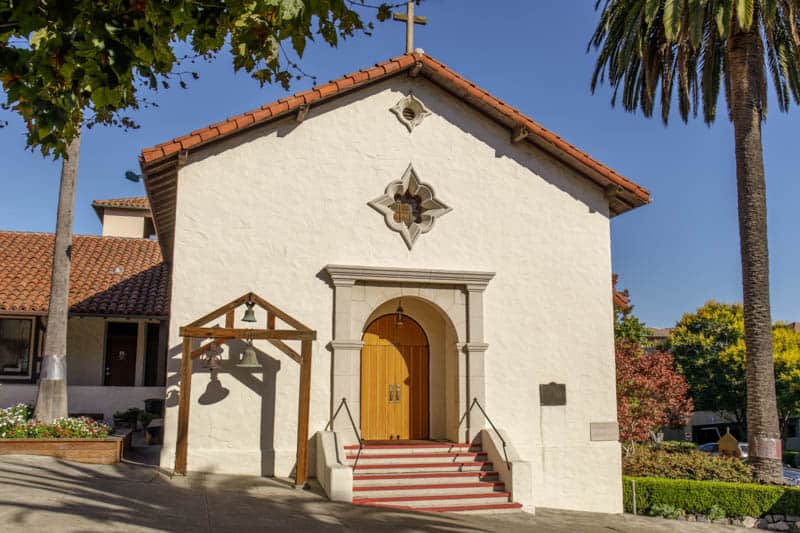
In 1822, with the success of the location, it was turned into a mission. The original buildings had to be razed because they fell into severe disrepair following secularization.
The current church is a replica of the 1818 structure, and its facade has a star window, like the mission church in Carmel. This mission did not have a bell tower: the bells hung on a frame just outside the church.
The interior of the San Rafael Mission is somewhat modern, but the detailing is meticulous, and the chandeliers, designed to resemble those from the mission era, are gorgeous. The Stations of the Cross are carvings, not paintings.
Next door is the San Rafael Parish Church, worth visiting for its beautiful stained glass windows.
Location: 1104 Fifth Avenue, San Rafael, CA 94901
Mission San Francisco Solano
The last of the 21 California missions to be built, Mission San Francisco Solano was founded by Father Jose Altimira in 1823. It was founded without the prior approval of the church, and after Mexico declared its independence from Spain.
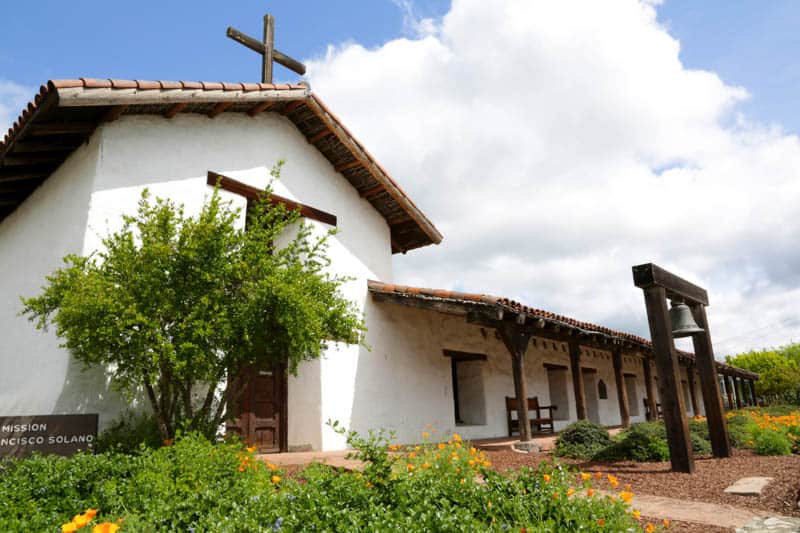
Mission San Francisco Solano is a part of the Sonoma State Historic Park, and the church is not active. The current church was completed in 1841, and the interior is not as ornate as some of the other missions.
You can see the mission right on the historic plaza in Sonoma.
The exterior of the mission is pleasing, with a bell frame holding the single surviving bell. Other than the church, the restored complex includes the padre’s quarters, which now houses the museum, and the quadrangle, which contains mature trees.
Sonoma also has the California Missions Museum, if you have more time. It contains scale models of all 21 missions, built for the California Pacific Exhibition in 1939.
Location: 114 E Spain Street, Sonoma, CA 95476
Map of the California Missions
*****
Did you find this article informative? Pin it for later reference!
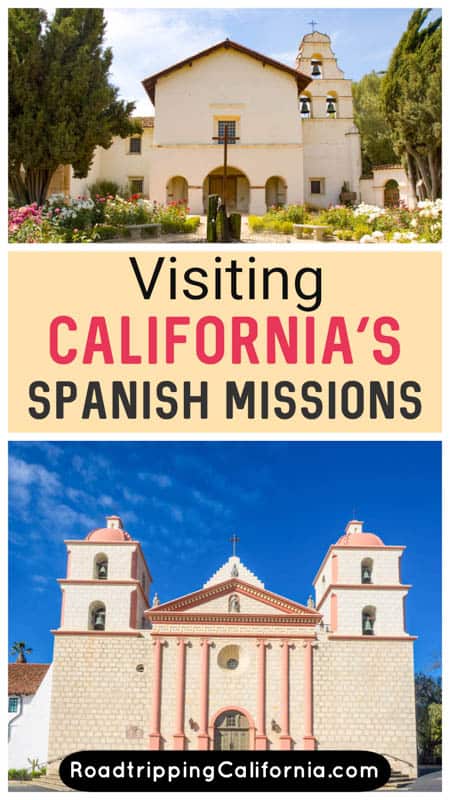

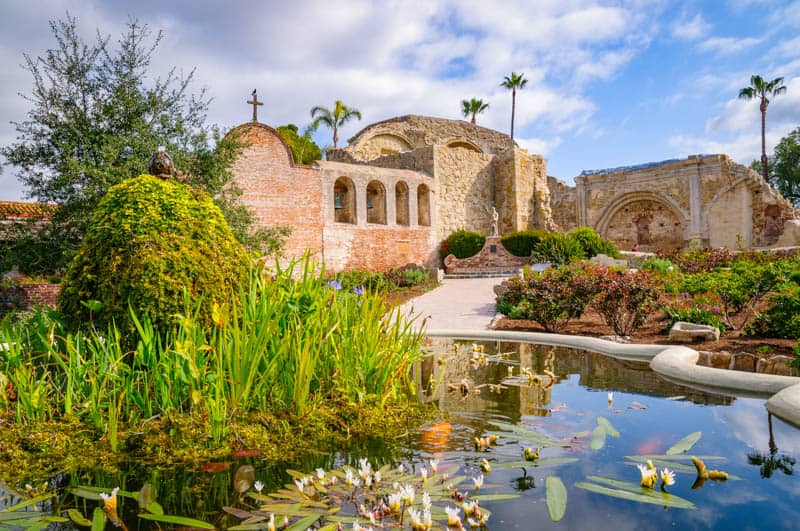
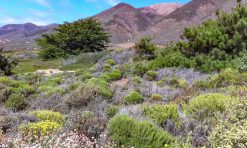
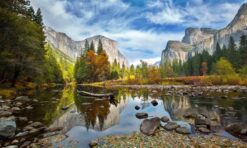
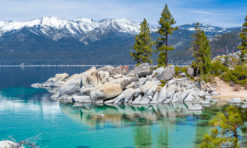
How many days would you allow for a tour of all the missions? We are hoping to plan a road trip accordingly, but not sure how long it will take to travel & visit them all.
Hi! You could do it in 7 days, but if you have a little more time to spare, 10 days would be a very comfortable trip.
We just did 16 missions in just under a week in an RV… Monday afternoon through Sunday morning, and it was really great but also challenging. The missions sometimes have very limited hours, most are generally in the 10-4 range, and some are closed a couple days a week, usually Mondays and Tuesdays. So it is hard to get an early start and fit a lot in during a day. We took 8 days for the trip because we had to then drive home- we pretty much drove straight down the 5 freeway back home. We did the 16 missions from north of LA to North of San Francisco. We are going to do two day trips to do the two east of LA and 3 south of us (we are in Orange County.) I think it would be hard to do all 21 missions at once in less than 9 days and you’d have to make sure you look up all the hours and plan carefully to make sure you’re not showing up when they are closed. Also, don’t forget to buy a mission passport at your first mission ($5) so you can collect all the missions stamps. The stamps are free and fun to collect, just ask at each gift shop. Note: Santa Clara doesn’t have a gift shop but you can go to the university book shop Monday through Friday and ask for the stamp there.
Thank you so much for writing in with your experience!